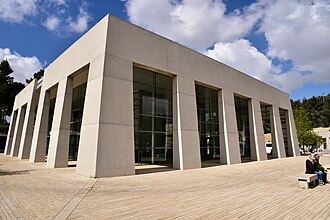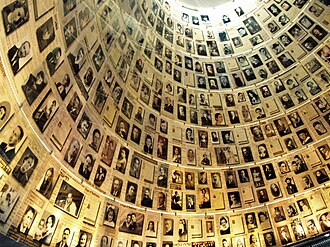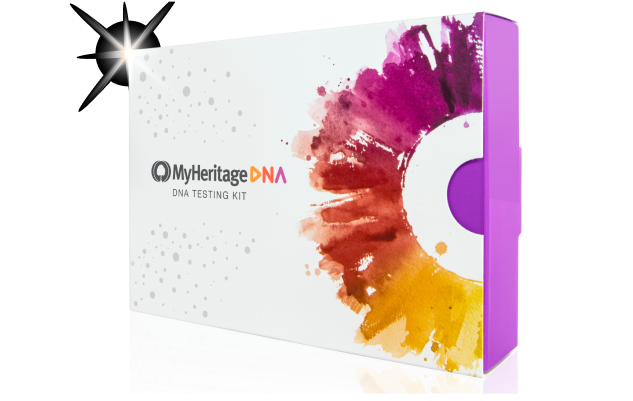Yad Vashem, also known as The World Holocaust Remembrance Center, is a world-renowned institution located in Jerusalem, Israel, dedicated to Holocaust remembrance, education, and research. Established in 1953, it serves as the official memorial for the six million Jewish victims who tragically perished during the Holocaust, as well as honoring the heroism of those who resisted Nazi oppression. The Yad Vashem Archives house the largest collection of Holocaust documents in the world: over 210,000,000 pages of documentation. The collections include over 131,000 survivor testimonies; over 500,000 photographs and approximately 4.8 million names registered in the Hall of Names.[1]
HistoryHistory

Yad Vashem's history is deeply rooted in the aftermath of the Holocaust, a devastating period during World War II when six million Jews, along with millions of others, fell victim to the horrors of Nazi persecution and genocide. The profound impact of the Holocaust on Jewish communities worldwide prompted a collective desire to establish a place of remembrance and documentation that would ensure the preservation of the memory of the victims and the atrocities they endured.
In the early 1950s, Jewish leaders, Holocaust survivors, and various organizations came together with the Israeli government to realize this vision. On August 19, 1953, the Knesset officially passed the Yad Vashem Law, providing the legal framework for the establishment of Yad Vashem as a national memorial and research center.
Yad Vashem opened its doors to visitors in 1957. The exhibitions focused on Jewish uprisings in the Treblinka and Sobibor death camps, resistance in the Warsaw Ghetto, and the struggle of survivors to reach the state of Israel. In 1993, the preparatory process began for the creation of a more significant, modern, and technologically advanced museum that would replace the old one. The new building was designed by Israeli-Canadian architect Moshe Safdie.
The name "Yad Vashem," meaning "hand and name," is derived from a biblical verse, Isaiah 56:5, which reads, "I will give them in My house and in My walls a hand and a name... I will give them an everlasting name." This poignant phrase reflects the institution's commitment to ensuring that the memory of the victims remains eternal and that their legacies are never forgotten.
Collections and archivesCollections and archives

Yad Vashem houses an extensive and diverse collection of historical materials from the Holocaust era, making it one of the most comprehensive repositories of its kind in the world. The Archives Division, in particular, serves as a treasure trove for researchers, historians, and genealogists seeking to understand the complexities and horrors of the Holocaust. This division preserves an extensive range of Holocaust-related documents, testimonies, photographs, and artefacts, including personal items and belongings of victims and survivors.
Of paramount importance is the Central Database of Shoah Victims' Names, which seeks to preserve the identities and memories of Holocaust victims. This comprehensive database includes names, biographical details, and, where available, photographs of individual victims, ensuring that their stories are recorded and commemorated for future generations. In addition, the Pages of Testimony initiative enables survivors and their descendants to provide personal testimonies, celebrating the lives of those who perished and further enriching the memorialization efforts.
From its inception, Yad Vashem aimed to fulfil three fundamental purposes: to commemorate the six million Jewish victims of the Holocaust, to honor the heroism of those who resisted and risked their lives to save others, and to educate future generations about the Holocaust's significance and lessons.
The task of establishing Yad Vashem as a comprehensive memorial and documentation center was immense. Holocaust survivors and their families played a crucial role in contributing personal artefacts, testimonies, and documents to create a comprehensive historical record of the Holocaust. Over the years, the institution has continually expanded its collections through research, outreach, and donations from survivors and their descendants, as well as other individuals and institutions.

The commemorative aspect of Yad Vashem is perhaps most symbolized by the Hall of Names, a vast repository housing millions of Pages of Testimony, each bearing the name, photograph (when available), and biographical details of individual victims. This ongoing project reflects the institution's dedication to preserving the identities and memories of the victims, making it a place of remembrance and solace for descendants and visitors alike.
Beyond its role as a memorial, Yad Vashem has become a vital hub for research and education on the Holocaust. It houses the International Institute for Holocaust Research, fostering academic studies and facilitating groundbreaking research by scholars from around the world. The institution's International School for Holocaust Studies offers educational programs, seminars, and workshops to educators, providing them with the tools to teach about the Holocaust accurately and effectively.
Yad Vashem plays a pivotal role in genealogy research, providing an invaluable resource for individuals seeking to uncover information about their relatives who were affected by the Holocaust. The institution's dedication to preserving the memory of Holocaust victims and survivors has led to the establishment of comprehensive databases and initiatives tailored to genealogical inquiries.
Yad Vashem databases for genealogical researchYad Vashem databases for genealogical research
Central Database of Shoah Victims' Names
At the heart of Yad Vashem's genealogy research efforts lies the Central Database of Shoah Victims' Names. This vast repository is a collective endeavor to record and memorialize the identities and life stories of the millions of Jewish victims who perished during the Holocaust. The database contains meticulously compiled records, including names, birth dates, locations, and, when available, photographs and personal details. Descendants and relatives can access this database to trace their family histories and connect with their past, creating a sense of closure and honoring the memory of their ancestors. MyHeritage offers records of Jewish people living in Romania and Hungary during World War II compiled from records found in Yad Vashem: Romania Claims Conference from JewishGen and Hungary Claims Conference from JewishGen.
Pages of Testimony[2]Pages of Testimony[2]
A crucial aspect of Yad Vashem's genealogy research is the Pages of Testimony initiative. This program invites survivors and their descendants to submit personalized testimonies, commemorating individual victims and survivors alike. These Pages of Testimony often include not only vital information such as names and dates but also heartfelt narratives that provide a more personal glimpse into the lives of those who experienced the Holocaust firsthand. By submitting these testimonials, families contribute to the preservation of their relatives' stories, ensuring that their legacies endure and are passed down to future generations. The first 800,000 Pages of Testimony were collected in the 1950s. Today there are approximately 2.7 million names registered on Pages of Testimony, recorded in more than 20 different languages.
Explore more about Yad Vashem:Explore more about Yad Vashem:
- Yad Vashem
- Signed, Your Father in a Nazi Prison: An Extraordinary Collection of Letters at MyHeritage
- Genealogical research at Yad Vashem at JewishGen.com


